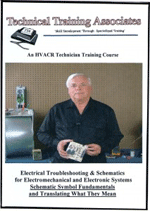The article contains comments from Todd M. Rossi, Jon D. Douglas, and Marcus Bianchi, all of Field Diagnostic Services, Inc., Langhorne, PA; and notes from the training departments of American Standard and Carrier Corp. For more detailed information, contact your equipment manufacturer and/or distributor.

OPERATING PRESSURE POINTS
“Systems using R-410A operate at higher pressures [than R-22],” points out the Field Diagnostics team. “For example, to produce an evaporating temperature of 40 degrees F and a condensing temperature of 115 degrees, the suction and head pressures would be 83 psia and 257 psia in an R-22 system, while they would be 133 and 406 psia, respectively, in an R-410A system.”Figure 1 shows the saturation pressures of R-410A, -22, and -134a for a range of temperatures in air conditioning applications. (The pressures for R-134a are shown as a comparison.)
Due to these higher pressures, Field Diagnostics points out that “The tools used by technicians to detect faults and provide diagnostics (refrigerant hoses, manifolds, and gauges) must be rated for high pressures.” Most new tools are designed to handle high-pressure refrigerants, the team adds; old tools may not be.
Carrier’s Puron® Quick Reference Guide mandates the following:
And the following information from American Standard’s Field Service Repair Guide for R-22 and -410A split systems is obvious but critical: “R-410A is not a drop-in replacement for R-22. R-22 equipment designs cannot accommodate the higher pressures of R-410A.”
Not only would the new, high-pressure refrigerant cause the old, lower-pressure-designed system to break down in short order, it would also create a dangerous situation for the next service person who came to look at the unit.
OUT WITH THE OLD OIL
Polyolester (POE) oils used with 410A absorb moisture, making them much less forgiving of service shortcuts than were the mineral oils used with R-22. If you take those shortcuts on 410A systems and allow air into the system, you can watch your profits evaporate. Air leads to moisture, and with a POE in the system, moisture leads to acid and sludge.“Care must be taken when replacing an R-22 system with an R-410A system,” explains American Standard. “If the old line set is going to be reused, ensure that as much of the mineral oil as possible is removed from the system before installing a 410A unit.” The line set’s correct size also should be confirmed.
Furthermore, “When retrofitting an old system or installing a new system, a new 410A evaporator with an R-410A TXV also must be installed.”
Keeping air out of the 410A system is critical to the system’s operation. However, the same methods to remove air and noncondensables that contractors have used on R-22 systems will not work on 410A systems.
American Standard points out, “Proper evacuation to 500 microns will remove moisture from an R-22/mineral oil system. However, evacuation to 500 microns will not sufficiently remove moisture from a system using POE oils such as those used with R-410A.”
“Never open a system to atmosphere while it is under vacuum,” states Carrier. “When the system must be opened for service, recover the refrigerant, then break the vacuum with dry nitrogen and replace the filter-drier. Evacuate the system to 500 microns before recharging.”
Here’s another difference between 22 and 410A systems: All R-410A units require a liquid-line drier. However, “The driers used with R-22 and -410A systems are different from one another,” states American Standard. “Specifically, R-410 systems use liquid-line driers rated for minimum working pressures of 600 psig. The desiccant materials must be compatible with POE oils and R-410A.”
Carrier further explains:
TROUBLESHOOTING WITH GLIDE
“Technicians used to working with R-22 systems may be unfamiliar with temperature glides,” acknowledges the Field Diagnostics team. “The concentrations of liquid and vapor at the saturation region of R-410A are never equal.“At a given pressure, the temperature at which a saturated vapor starts to condense (dewpoint) is higher than the temperature at which a saturated liquid starts to boil (bubble point). This temperature difference is called temperature glide.”
The company further points out that because R-410A is a near-azeotrope, its temperature glide is smaller than 0.2 degrees, “which is negligible. Most R-410A saturation tables used in the field do not show the temperature glide.”
The manufacturers’ trainers The News spoke with agree that R-410A behaves so similarly to R-22 in this respect, contractors are quite comfortable with it.
“We encourage the use of fault detection and diagnostics algorithms based on fundamental principles,” states the Field Diagnostics team. “Some rules of thumb are used in the field. Any pressure-based rule based on experience with R-22 is not applicable on R-410A units.
“For example, measuring the head pressure and comparing it to a threshold (for example, 280 psig) to detect a dirty condenser does not work. [However], converting high- and low-side pressures to condensing and evaporating temperatures, respectively, and basing diagnostic reasoning on these temperatures instead of pressures makes the algorithm less sensitive to changing refrigerants.”
This article touches the surface of many important service points related to R-22 and -410A. It is critical that contractors contact their equipment manufacturers, through their distributors, for more detailed training.
Publication date: 05/20/2002






